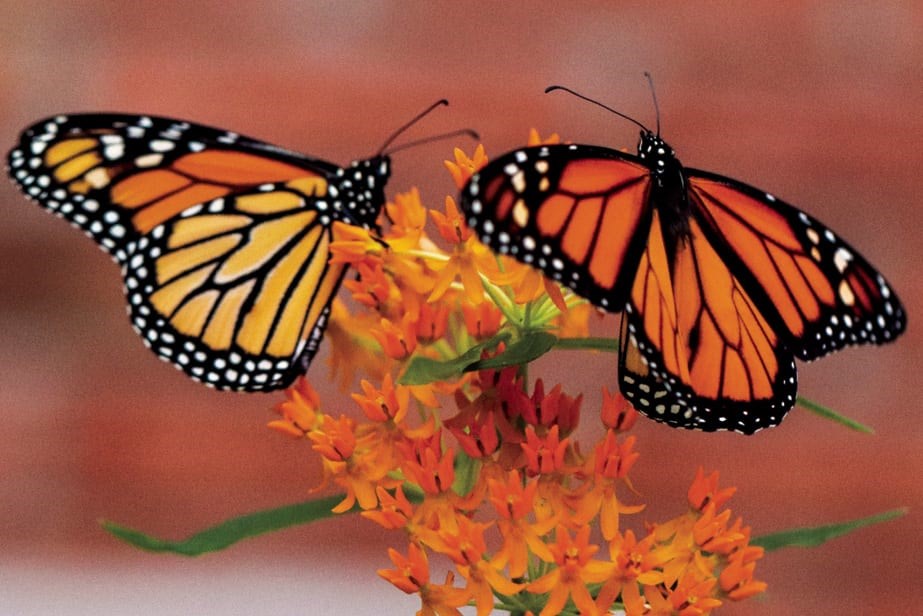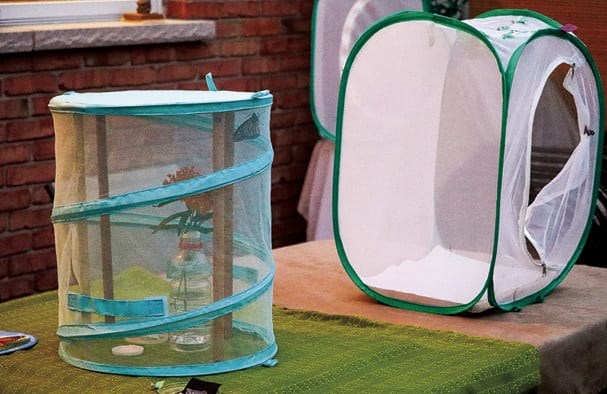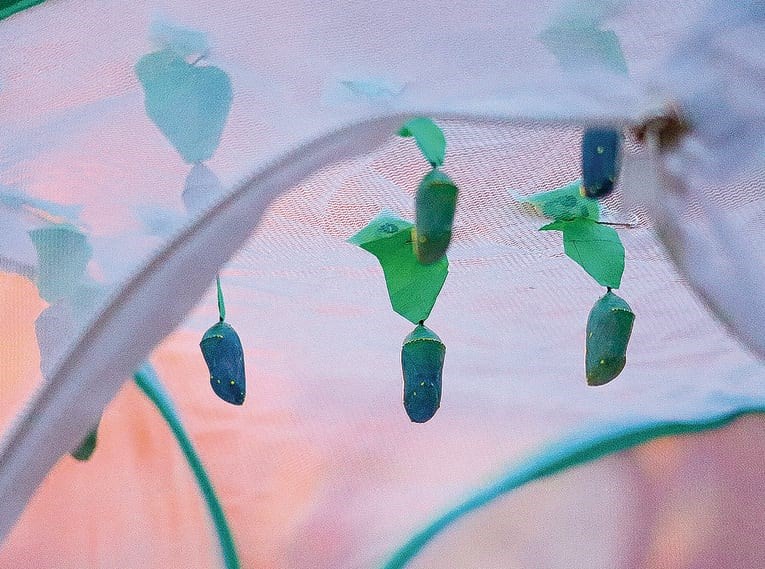This year Judy Hagadorn has hand-raised 70 of the increasingly endangered butterflies, egg to adulthood
Despite the rain and thunder outside Judy Hagadorn’s home on Rolling Meadows Boulevard, the two monarch butterflies sheltering inside her sunroom seemed perfectly at ease. Inside a small wooden habitat with mesh panels, the butterflies sipped from a little dish of water and honey, awaiting their release into the wild when calmer weather arrived.
Another mesh habitat sat on the table— this one full of chrysalises, the hardened outer layer of butterfly pupae—each labeled by number and pinned to the top of the habitat. More monarchs were scheduled to arrive soon, as evidenced by the darkening of the chrysalises which were most mature.
“They are fascinating creatures. I love it,” said Hagadorn, opening the butterfly habitat. One butterfly hopped obligingly onto her finger, then fluttered to her shoulder, eventually nestling in her hair.

Hagadorn was inspired to raise monarchs after visiting a friend in Thunder Bay in 2018. The friend raised monarchs in a big wood and mesh indoor habitat, and Hagadorn was able to observe the butterflies grow in all their different stages. While she was only able to raise and release five monarchs in 2019, she has been able to raise 73 butterflies this year.

According to National Geographic, female monarch butterflies will lay between 300-500 eggs on the leaves of milkweed plants. Once the egg hatches into larvae, or caterpillars, they will exclusively eat milkweed for two weeks before spinning a cocoon and forming a chrysalis to enter the pupa stage. After another two weeks, they emerge as orange and black adult monarch butterflies.
Since the 1980s, Western monarch butterfly populations have faced a 99 percent decline, while Eastern monarchs have declined by almost 80 percent. Aside from climate change, the use of pesticides, herbicides, and excessive mowing has resulted in less milkweed available as a habitat and food source for monarchs.
Milkweed is an integral part of Hagadorn’s self-titled “COVID Project.” When she first began rearing monarchs in 2019, Hagadorn collected milkweed pods from a friend in Effingham who owned several acres of milkweed. After separating the seeds by hand, she put them in a plastic bag and into the fridge to encourage gemination through cold stratification. She was then able to transfer 15 plants to her garden and keep 20 plants in her sunroom to feed the five caterpillars she brought inside.
In 2020, Hagadorn’s milkweed regrew and at four to five feet tall was the perfect place for monarchs to lay eggs. She noticed the first butterfly laying eggs on July 3 and was able to eventually collect 39 eggs and 42 caterpillars in different stages.

Over the course of two months, Hagadorn disinfected leaves, separated caterpillars into containers, and moved pupae into a separate habitat to keep them organized and safe and give them enough room to emerge.
Hagadorn’s husband, Wayne, who laughingly described himself as “only the assistant,” described the process of moving the pupa to the second mesh habitat as Judy’s “surgery” (it required small scissors, pins, and masking tape). He frequently kept dinner warm for an extra half hour while Judy made sure the caterpillars were fed and safe for the night. He plans to build a wood and mesh habitat for Judy to continue raising caterpillars and butterflies in 2021.
Judy Hagadorn has appreciated the project for helping her to pass the time during the COVID-19 lockdown while also allowing her to aid monarch conservation efforts. The care and feeding of the caterpillars from egg to adult stage has given her an opportunity to observe some interesting behaviour, such as caterpillars (described as “feisty”) bickering over leaves, and butterflies with distinct personalities. Some butterflies were energetic, while others seemed more laid back.
Hagadorn says that it feels good to save monarchs and give them a safe and healthy place to form a chrysalis and emerge without fear of predators or pesticides. After releasing them, she “misses them when they are gone,” especially after raising them from the egg stage.
She looks forward to raising more butterflies next year and after the last of this year’s group have emerged and are released, will focus on her other COVID project, sewing masks. As her caterpillars grew and shed their skin, both Judy and Wayne noticed that their face sheddings looked like tiny little masks.
“They have their own masks to protect them from COVID,” said Wayne with a chuckle.


